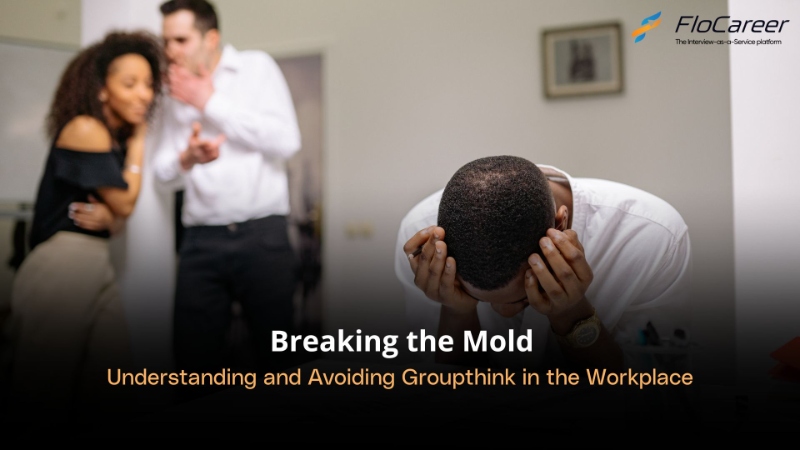Breaking the Mold: Understanding and Avoiding Groupthink in the Workplace
In the complex landscape of the workplace, the concept of groupthink emerges as a psychological phenomenon that can significantly impact decision-making within a group. Groupthink occurs when a group of individuals collectively makes decisions or takes actions that may not be in the best interest of the entire group. It is crucial to comprehend the dynamics of groupthink, recognize its symptoms and causes, and, most importantly, explore strategies to steer clear of its detrimental effects.

What is Groupthink in the Workplace?
Groupthink in the workplace represents a collective behavior observed in groups, where members tend to suppress their individual thinking to maintain group unanimity and avoid conflicts. This inclination can lead to irrational decision-making and unfavorable outcomes for the group as a whole. It's essential to distinguish groupthink from conformity bias, as the former involves overriding individual thinking to preserve consensus, while the latter refers to aligning with the majority.
The repercussions of groupthink are extensive, encompassing poor decision-making, stifled dissent, reduced creativity, inefficient problem-solving, diminished morale and involvement, overlooked opportunities and risks, organizational stagnation, and overall adverse outcomes.
Examples of Groupthink in the Workplace
Illustrating instances of groupthink in the workplace provides insight into its pervasive nature:
In situations where employees are voting on forming a union, the likelihood of agreement may increase if they perceive themselves as part of a larger group rather than making an individual decision.
Decisions related to work schedules can be influenced by groupthink, making it easier for employees to reach a consensus when they feel part of a larger group.
Recognizing Symptoms of Groupthink
Identifying symptoms of groupthink is imperative to address this phenomenon effectively:
Rationalization: Group members conform their thinking to the group's opinion to avoid conflict or embarrassment, leading to poor decision-making.
Self-Censorship: Members start believing in the group's consensus, even when irrational, suppressing dissent and impacting productivity.
Stereotyping: Strong convictions hinder objective evaluation, making decisions that favor the group over individual members' best interests.
Peer Pressure: Destructive workplace force causing conformity to group opinions, resulting in suboptimal decision-making.
Illusions of Invulnerability: Cognitive distortion occurs when the group seeks consensus to shield itself from criticism, sacrificing accuracy and truth.
Morals and Beliefs: Groupthink discourages challenging prevailing views, leading to flawed decisions and suppressed dissent.
Causes of Groupthink in the Workplace
Understanding the root causes of groupthink aids in mitigating its impact:
Fear of Adverse Outcomes: Common in large organizations, where pressure to produce quick results can trigger groupthink, as members fear reprisals.
Poor Leadership: Manifests as reluctance to challenge ideas, failure to analyze alternative viewpoints, and a lack of open discussion.
Lack of Diversity: Homogeneous groups tend to make decisions reflecting their views, leading to flawed thinking and decision-making.
Lack of Knowledge: Quick and inaccurate decisions occur due to cognitive bias in group settings, fostering groupthink.
Stress: Unconscious conformity to group norms, even if it results in poor decisions, is heightened under stress.
Isolation: Factors like strong leaders, fear of conflict, lack of information, and closed communication contribute to an atmosphere conducive to groupthink.
Avoiding Groupthink: Strategies for the Workplace
Mitigating the impact of groupthink requires proactive measures:
Diversify Teams: Promote diversity by hiring candidates with varied backgrounds, religions, cultures, and experiences. This approach fosters a multitude of perspectives, reducing the risk of groupthink. A diverse team brings a richness of ideas and insights that can lead to more robust decision-making.
Inclusive Leadership: Infuse inclusiveness into leadership practices, beginning with job descriptions. Create an environment that encourages open discussions, values diverse opinions, and supports collaborative decision-making. Inclusive leaders set the tone for a culture where every team member feels heard and respected.
Evaluate Communication Style: Cultivate an atmosphere that values open discussion and debate. Leaders should actively create a safe space where individuals feel comfortable expressing dissenting opinions. By fostering a culture of respectful disagreement, teams can explore a broader range of ideas, mitigating the risk of conformity.
Encourage Sharing: Establish an environment that encourages team members to freely express dissenting opinions. Encourage the exploration of different options and the development of creative solutions. When individuals feel empowered to share diverse perspectives, it can lead to more comprehensive decision-making processes.
Offer Learning Opportunities: Continuous learning is a powerful tool in preventing groupthink. Provide opportunities for skill development, training, and exposure to new ideas. Encourage team members to explore various options and perspectives, fostering a culture of curiosity and innovation.
Regular Performance Reviews: Conduct objective and unbiased performance reviews as a routine practice. Focus on individual improvement rather than upholding group norms. This approach ensures that each team member's contributions are recognized and assessed independently, reducing the influence of group dynamics.
Rotate Team Roles: Periodically rotate team roles and responsibilities to avoid fixed perspectives. This strategy prevents individuals from getting entrenched in specific roles and encourages a dynamic exchange of ideas within the team.
External Input and Consultation: Seek external input or consultation on significant decisions. Bringing in perspectives from outside the immediate team can offer fresh insights and challenge any potential groupthink. External viewpoints act as a valuable counterbalance to internal dynamics.
Promote Devil's Advocacy: Designate a team member or encourage a rotating role as a "Devil's Advocate." This person challenges prevailing opinions and decisions, fostering a culture where critical thinking is valued, and alternative viewpoints are considered.
Utilize Technology Platforms: Implement technology platforms that facilitate anonymous idea-sharing or feedback. This can empower team members to express dissent without fear of reprisal, encouraging a more open and honest exchange of ideas.
Transforming Interviews for Unbiased Decisions
In the quest for unbiased decision-making during interviews, outsourcing with Flocareer emerges as a strategic solution. Flocareer's commitment to diverse, structured, and unbiased interviews aligns seamlessly with global standards. By outsourcing interviews with Flocareer, organizations can ensure a fair and impartial evaluation of candidates, mitigating the risks associated with groupthink. Embrace the transformative approach of Flocareer to elevate your recruitment practices.
Check out our latest blog on AI Interview Notes


